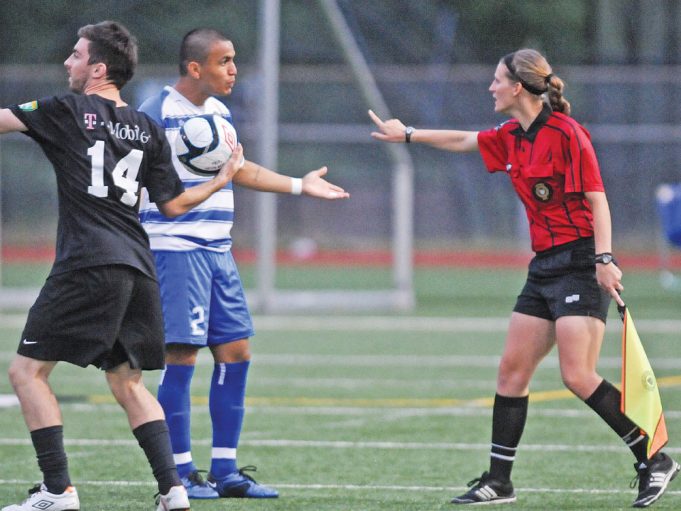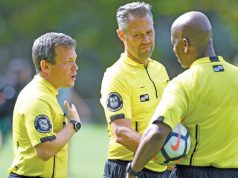A
chieving excellence takes knowing what the referee’s powers are and, more importantly, when and how best to use each power to successfully manage a match. There are six ways for referees to control behavior. Each has a powerful effect on team and player behavior, and when used correctly, can assure a well-managed match.
Talk
The right thing said to a player at the appropriate time can assist in avoiding problems later in the match. Referees should talk to players throughout the match as needed to keep their behavior at an acceptable level. Talking to a player is a way to give counsel, advise or verbally warn on how to control or improve behavior. Referees must learn how to judge when to do so, and what to say. It also implies that all referees are capable of saying the right thing, at the right time and in the right way. Every referee has a different personality and that impacts how effective these communications will be.
The first tip to a referee is to realize whether or not his or her efforts to talk to players have been successful and yielded positive results. If not, the referee should consider adjusting techniques used and reach out to an experienced official for tips on how to improve. Every referee has to learn independently what works. For example, one referee is very successful by telling a player, “If I allow you to do that, I have to allow all of the other players on the field to do the same and not be penalized. I am not about to let that happen.” More often than not, that will cause the player involved to adjust behavior.
Another example is, “You are a better player than that. Let’s focus on your talent and not fouling.” In that instance, the referee is letting the player know the foul is unacceptable while also acknowledging the individual is a good player (positive comment).
It is important to remember that no one way is the best when communicating with a player. Each instance is separate, and each player will react differently. Adjusting comments and how they are delivered will help the referee control behavior. Talking is an important first step in maintaining control.
Whistle
The judgment of when and what to whistle for when judging a rule violation, offense or misconduct is entirely subject to the referee’s opinion. The phrase “in the opinion of the referee” means that every decision is discretionary based on what the referee observes and the flow of the match.
The referee has an obligation to call rules violations and infringements as they occur. Many referees make the mistake of trying to avoid stopping the match for violations because referees fear too much whistling will interfere with the “flow” and “enjoyment” of the match.
A referee should not call trifling occurrences but must not allow unfair play without interceding by penalizing the offender.
Every referee must learn what is unfair play and develop a strong sense of what violates the sense of fair play and sportsmanship around which soccer is built. Experience is one of the best teachers for learning that skill.
When a violation occurs, signal with the whistle without hesitation. If the players continue to foul, the referee must continue to sound the whistle and not worry about the game flow.
The whistle can also be used to let players know how the referee feels about the foul or situation. A quick, short whistle implies the referee observed the foul and wants to get the ball back into play. A hard, loud whistle indicates the referee is not happy with the situation and the player(s) involved need to adjust behavior.
When awarding a penalty kick, it is imperative the referee uses a hard, forceful whistle. That indicates to the players the referee is 100 percent certain the penalty should be awarded. An indecisive whistle for a penalty kick will normally result in additional dissent and questioning of the call and future referee decisions.
Advantage
The proper application of advantage is a very tricky technique. When applying advantage, the referee is letting the players know the referee is allowing unfair play to continue without penalizing the offender. The referee has determined a foul that occurred would be penalized if play was stopped. When applying advantage, the referee should consider the level of play, the age of the players and the skill levels. Also, the referee must be ready to take a follow-up action if necessary, such as a warning, caution or ejection to the player who caused the foul.
When applying advantage, the referee should make sure as many players as possible observe the signal of the out swinging hands. The signal should continue sufficiently long enough to let players know the advantage is being applied. Some officials verbalize “Play on, advantage” while giving the signal so every player is aware of the call.
Advantage should never become a license for foul play. A referee who allows too much advantage, especially when there are hard fouls, will normally lose control of the match and have serious problems with match control. Learning to use that power properly helps improve the referee’s ability to control player behavior and allow a good flow to the match.
Caution
The caution is a very strong power for a referee. When administered, the player is now halfway out of the match and must realize that. If the player does not change behavior, the player will be ejected.
When issuing a caution, the referee must be firm but professional and calm. That is an emotional time, and the referee should not exhibit any mannerisms that appear to be confrontational, threatening, etc.
The referee should complete the process as quickly as possible. The referee must record the player’s number, the time of the event and the reason for the caution. The referee informs the player he or she is being cautioned and the reason for it. That is the end of the conversation, and the match is restarted. The player’s future conduct will determine if he or she will remain in the match.
Often, the player involved may question the referee’s action or make additional comments. The referee must determine how much conversation is permitted and when it crosses the line and becomes dissent. The referee must exhibit the ability to allow the player a few moments and then gain control of the situation. Debating with the player is a no-win situation for the referee. Just listen for a reasonable amount of time and move on.
The issuance of a caution is a formal action and, in many instances, requires a written report to the appropriate governing body. That report should only indicate the facts and not opinions or feelings of the referee. It must be submitted within the time frames specified by the league.
Ejection
That is the strongest power the referee has to use in disciplining a player. It allows the referee to penalize the player by preventing the player from taking part in the remainder of the match and more than likely a future match. Most leagues require a player to sit out at least one game after an ejection.
The procedures for issuing an ejection are the same as a caution. Emotions will be even higher than a caution and the referee must remain calm and professional.
Once a decision to eject a player is made, there is little need for conversation. Merely advise the player what the ejection is for and display the red card. After the player leaves the field, make the necessary notes and ensure the player is removed from the area.
Note: For a match played under NFHS rules, the player is restricted to the team area. If the player becomes a problem within the team area, the referee must advise the coach to correct the problem, or it may be necessary to terminate the match.
Again, after the match, the referee must provide an accurate and complete report about the ejection and forward to the appropriate individual within the required time frames.
Terminate
That is a very powerful discretionary power. When a match is terminated, the referee has determined the only course of action left in dealing with player or team behavior is to not allow the match to proceed. Terminations do not happen often and only when the referee determines team behavior is so extreme it has impacted the match to a point player safety is involved.
If a match becomes too large a problem to control, the referee should not hesitate to determine the match should be terminated.
The referee must stop the play, then clearly and briefly inform both coaches that the match is being terminated. No further conversation is required. Again, the referee must complete the appropriate report and submit it to the appropriate authority in a timely manner.
The above describes various ways to control behavior. Each referee’s personality and the type of play will help determine what course of action should be used during any given situation. The referee is the only one who can decide what action to take.
What's Your Call? Leave a Comment:
Note: This article is archival in nature. Rules, interpretations, mechanics, philosophies and other information may or may not be correct for the current year.
This article is the copyright of ©Referee Enterprises, Inc., and may not be republished in whole or in part online, in print or in any capacity without expressed written permission from Referee. The article is made available for educational use by individuals.



















